Additional information
| Publisher | Edge Enterprises, Inc. |
|---|---|
| Year Printed | 2007 |
| Includes | Manual and CD |
$44.00
| Publisher | Edge Enterprises, Inc. |
|---|---|
| Year Printed | 2007 |
| Includes | Manual and CD |
Overview
The Concept Anchoring Routine is used by teachers to teach students about a new concept by relating it to a familiar concept. To test the effects of a CD program for instructing teachers in how to use the Concept Anchoring Routine, a study was conducted with 24 general education teachers who taught grades 4 through 12. They were randomly selected into an experimental and a control group. Twelve teachers worked through this CD program (hereafter referred to as the “virtual workshop” [VW] group) to learn how to use the Concept Anchoring Routine. They used the routine in their general education classes with a total of 187 students, 33 of whom had learning disabilities (LD). Twelve teachers (hereafter referred to as the “actual workshop” [AW] group) participated in a live workshop to receive instruction from one of the developers of the routine. These teachers used the routine with a total of 184 students, including 42 students with LD. The purpose of the study was to determine whether the virtual workshop created through the CD program was as effective as the actual live workshop. A multiple-baseline across-teachers design was used to determine the effects of instructing the teachers. A pretest-posttest control-group design was used to determine the effects of the teachers’ instruction on student learning.
Results
The teachers’ implementation of the Concept Anchoring Routine was measured before and after the instruction. The results are shown in Figure 1. The posttest (after-training) scores of the two groups of teachers were compared using an analysis of covariance, with the baseline scores serving as the covariate. There was no significant difference between the groups’ implementation scores after instruction, F(1, 21) = .97, p = .34, revealing that the virtual workshop (the CD) was as effective as the actual workshop. A repeated measures analysis of variance revealed a significant difference for both groups of teachers between their baseline and posttest scores, F(1, 22) = 1018, p < .001.
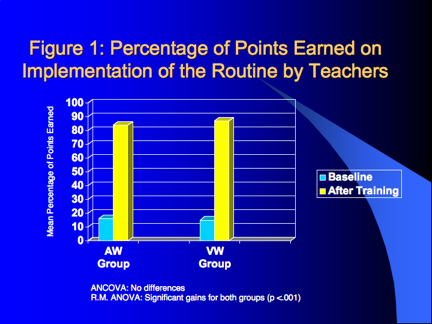
Figure 2 displays the mean percentage scores the two groups of teachers earned on a test of their knowledge of the Concept Anchoring Routine. Analysis of Covariance (ANCOVA) revealed no significant difference between the posttest scores of AW and VW participants after controlling for their pretest scores, F (1, 21) = .002, p = 0.966. Repeated measures analysis of variance indicated that the knowledge posttest scores of the teachers in both groups were significantly different from their pretest scores, F(1, 21) = 600.3, p < 0.001.
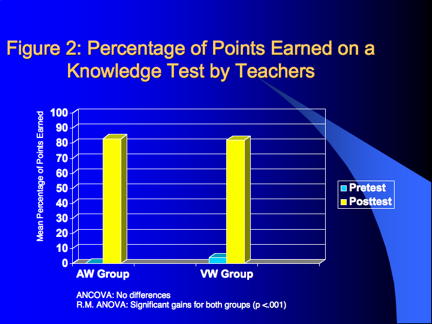
Figure 3 displays the mean percentage scores earned by the two groups of teachers when they completed an Anchoring Table, the graphic device on which the Concept Anchoring Routine is based. An Analysis of Covariance (ANCOVA) revealed no significant differences between the posttest scores of AW and VW participants, F (1, 21) = .425, p = 0.521. Repeated measures analysis of variance indicated that the posttest scores of the teachers in both groups were significantly different from their pretest scores, F (1, 22) = 5276.6, p < 0.001.
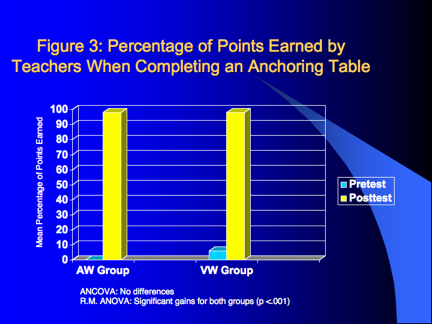
A Concept Acquisition Test was administered to students over a concept taught before the teachers were instructed and over a concept taught in the last observed lesson of the study. The test was comprised of open-ended items. Thus, students had to know the information and write it on the test, not merely recognize a correct answer in a list of multiple-choice items.
The Concept Acquisition Test was administered at the end of each designated lesson. Results for all the students are shown in Figure 4. Results for the students with LD are shown in Figure 5. The data were analyzed using a hierarchical linear model approach in which the two sources of variance were modeled: the variance of students within classrooms and the variance due to differences between classrooms. One analysis examined the posttest scores of all students whose teachers participated in the training. The results indicated that, after controlling for the level of the pretest, the scores of students in the classrooms of teachers who participated in the Virtual Workshop (worked through the CD) were significantly higher than the scores of students in the classrooms of teachers who participated in the Actual Workshop, F (1,23) = 7.04, p = .014. No significant differences were found between the scores of the two groups of students with LD, F(1,13) = 2.79, p = .119.
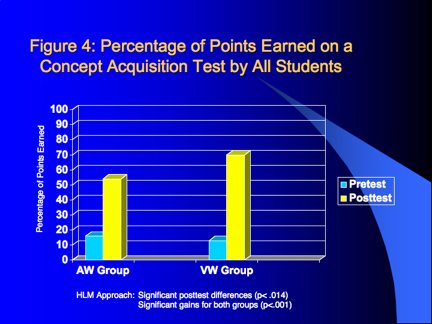
A second hierarchical linear model analysis was conducted to compare the scores on the posttest with the scores on the pretest across the types of training. This analysis showed significant gains in the scores of all students irrespective of the type of training that the teacher had received, F(1, 24) =151.3, p < .001. In a separate and similar analysis, the LD students showed significant gains from pretest to posttest, F(1,14) = 53.3, p < .001.
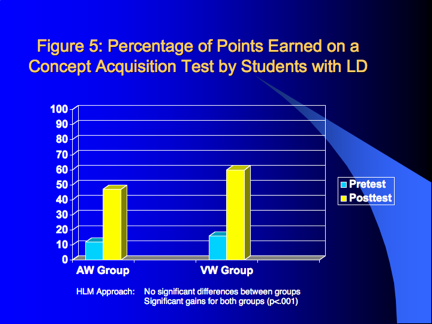
Conclusions
These results show that the Professional Development CD Program is as effective as live instruction with regard to instructing teachers in how to use the Concept Anchoring Routine. Both CD instruction (VW instruction) and live instruction produced mastery levels of performance in the teachers and significant differences between their pre-instruction and post-instruction implementation and knowledge scores. Furthermore, the CD Program appears to result in significantly higher levels of learning in students than the live workshop. Although there were no significant differences between the two groups of students with LD, the students with LD who were taught by the VW teachers earned higher scores than the students with LD who were taught by the AW teachers. All students made significant gains from pretest to posttest, regardless of the type of training their teachers had experienced.
References
Schumaker, J. B. (2003). Preparing teachers for academic diversity: Continuation report for SBIR Phase II Grant #R44HD36173 on the Concept Anchoring CD. Washington, D.C.:
National Institute of Child Health and Human Development, National Institute of Health.
data issue dc

 Professional Development Program for the Concept Comparison Routine (Manual...
Professional Development Program for the Concept Comparison Routine (Manual...